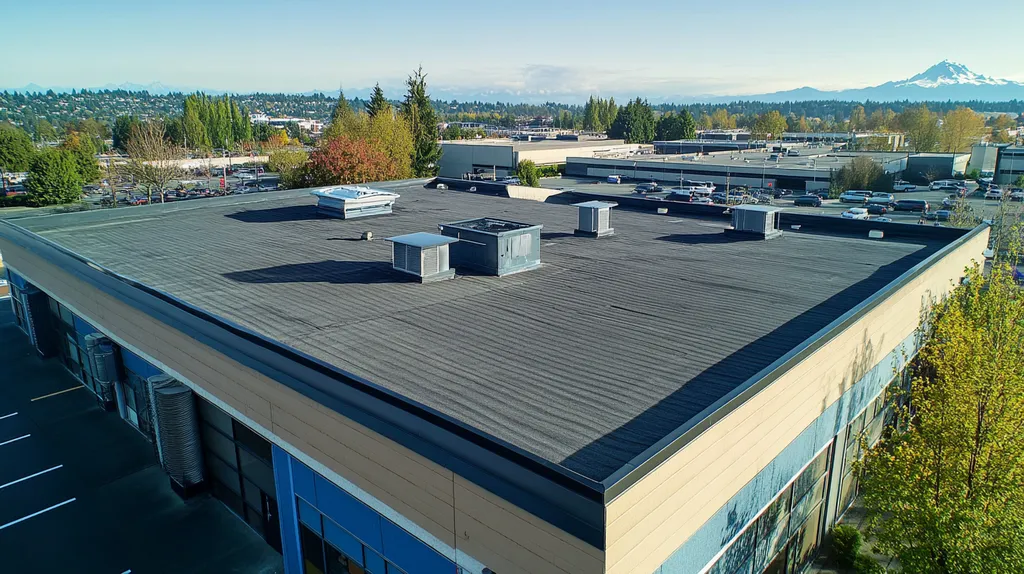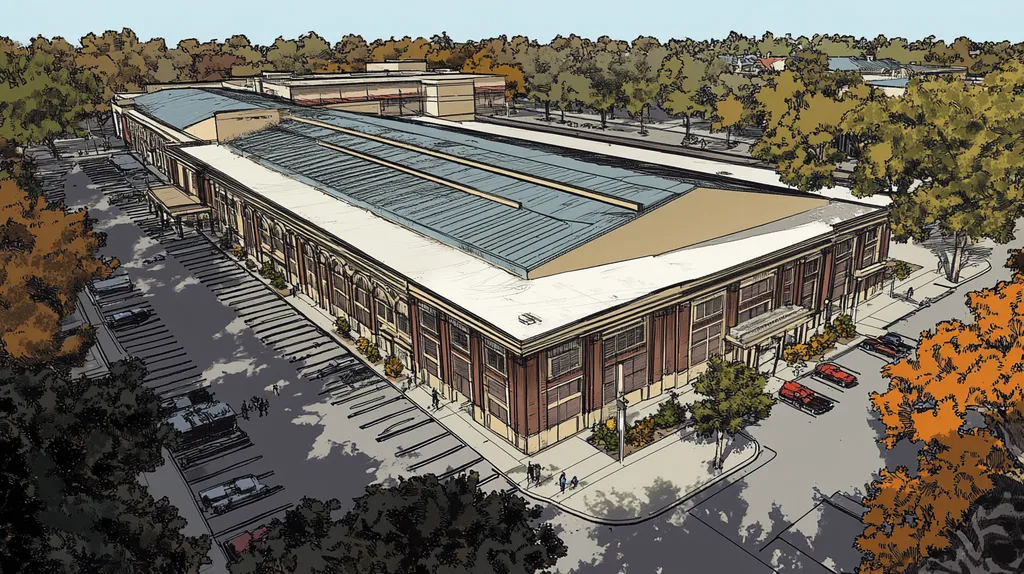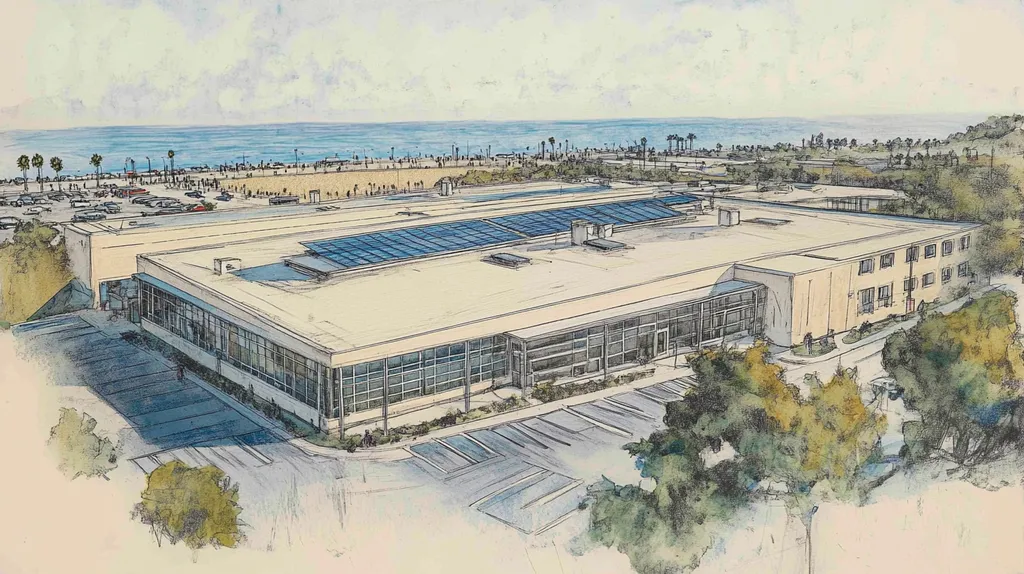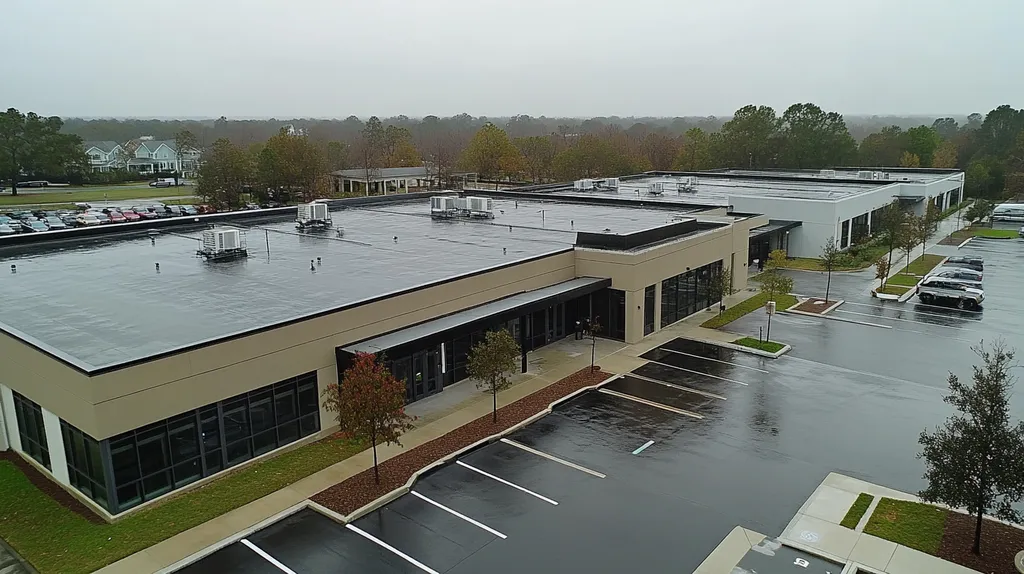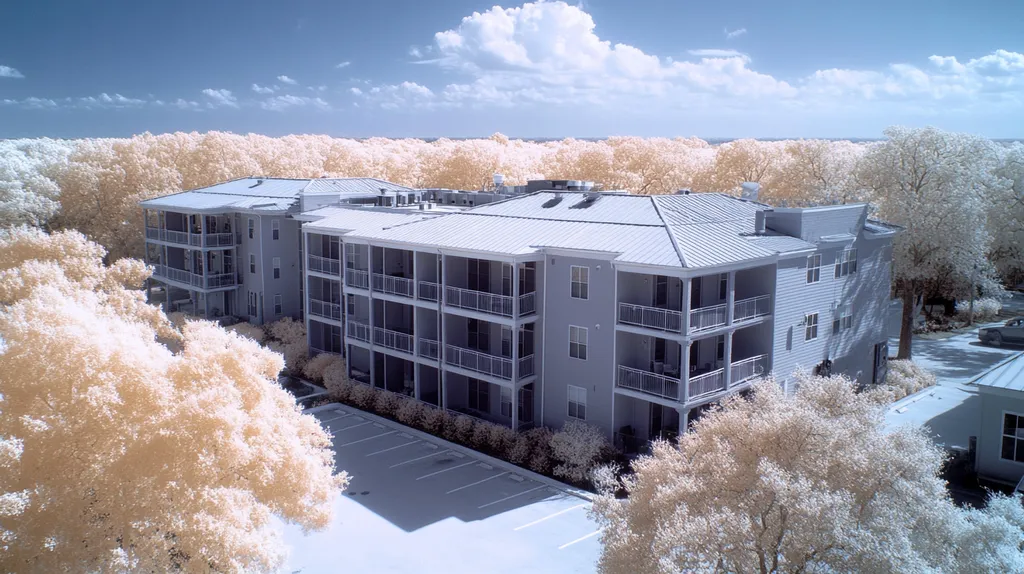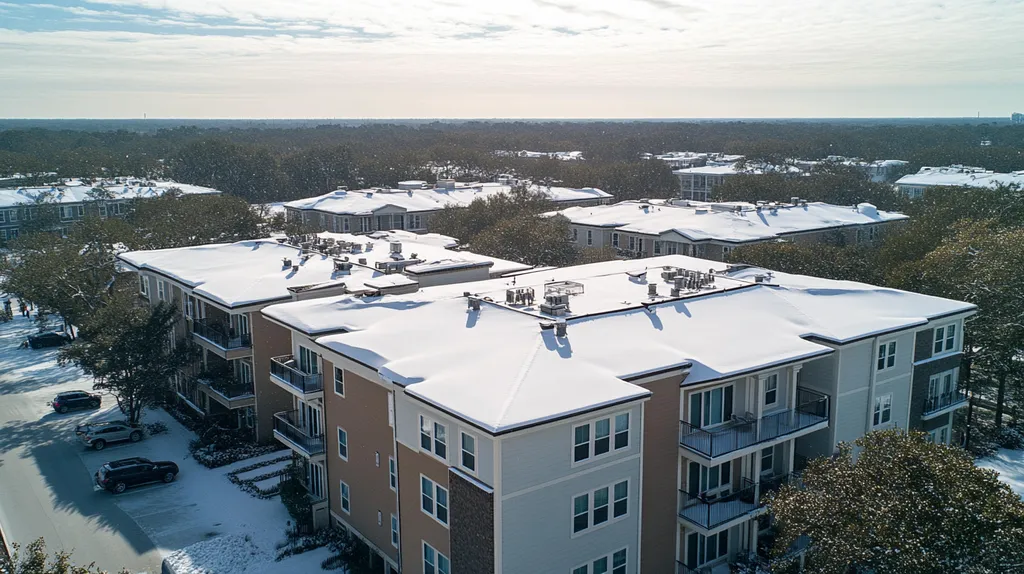In the past decade, commercial roof failures due to rainfall have surged by 40%, with coating application errors being the primary culprit. The rising frequency of extreme weather events has exposed critical gaps in traditional roofing practices.
While the industry once relied on basic waterproofing methods, today’s varied rainfall patterns demand a more sophisticated approach to coating selection and application timing.
This comprehensive analysis separates fact from fiction regarding rainfall’s influence on commercial roofing, examining everything from common misconceptions to evidence-based solutions that protect valuable roofing investments.
SECTION 1: COMMON MISCONCEPTIONS
The roofing industry grapples with significant challenges, largely stemming from myths surrounding rainfall and coating applications. Property owners often underestimate the critical impact that regional rainfall patterns have on the durability and effectiveness of their roofing systems. Such misconceptions can result in costly mistakes, like premature coating failure and escalating maintenance expenses. This section will clarify three prevalent misunderstandings about rainfall frequency and its crucial role in decision-making for commercial roofing.
Ignoring Regional Rainfall Patterns
A common belief among commercial property owners is that all roofing materials are equal, regardless of local rainfall patterns. However, regions with high precipitation, like the Pacific Northwest, require specialized approaches to coating applications, unlike drier areas such as Arizona. Ignoring local weather conditions can set the stage for significant roofing challenges.
When roofing materials fail to endure heavy rain, the result is accelerated degradation, leading to leaks and potential structural damage. Understanding the rainfall frequency in a specific area is vital for choosing suitable coatings that can withstand the expected weather.
Timing also plays a crucial role in coating applications. Even the highest-quality coatings need sufficient dry time, and persistent rain can disrupt the application process. Property managers must keep a close eye on weather forecasts, ensuring that coating applications are scheduled when the conditions are just right.
In short, factoring in regional rainfall patterns into roofing strategies is essential for maintaining roof integrity and avoiding unnecessary expenses.
Overlooking Material Vulnerabilities
An often-neglected aspect of roofing is the susceptibility of different materials to specific weather conditions. Many believe that standard pre-packaged roofing systems can handle all types of rainfall without issue. Yet, not all coatings offer equal moisture resistance, which can lead to costly complications.
For instance, certain coatings may perform acceptably in light rain but fail miserably under prolonged downpours, resulting in water intrusion that can cause structural damage and mold growth. Property owners must closely assess their materials’ vulnerabilities against local weather patterns to ensure optimal roofing performance.
Additionally, maintenance of roofs often takes a backseat after initial installation. Regular inspections are vital, especially in regions that experience frequent rainfall. By understanding the specific weaknesses of their roofing materials, property owners can take proactive measures to extend the life of their roofs and minimize unexpected repair costs.
Addressing material vulnerabilities based on rainfall patterns enables a more holistic approach to roof management. Staying informed about week-to-week weather conditions can significantly enhance the longevity of roofing solutions.
Misunderstanding Coating Durability
A widespread misconception in the roofing world is the belief that once a coating is applied, it will last forever. The truth is that environmental factors, particularly rainfall frequency, can dramatically influence the lifespan of roofing coatings.
Some coatings may boast extended service lives but may underperform in scenarios of heavy rain. For example, coatings that lack sufficient adhesive properties may erode over time under consistent moisture. Property managers often find themselves bewildered and frustrated by coating failures shortly after application, believing they made a sound choice.
Commercial property owners need to understand that claims regarding coating durability cannot be blindly accepted. Gaining insight into how a coating interacts with local rainfall patterns is crucial for ensuring it performs as expected.
Ultimately, investing in coatings proven to endure specific environmental conditions can lead to significant long-term savings. Awareness of how coatings respond to various rainfall scenarios supports informed decision-making and promotes sustainable outcomes for commercial roofs.
SECTION 2: PRACTICAL IMPLICATIONS
The frequency of rainfall is not just a weather pattern—it directly shapes the effectiveness and lifespan of commercial roofing systems. Recent data from the National Oceanic and Atmospheric Administration highlights a troubling trend: regions with increased rainfall are experiencing a rise in roofing failures. This underscores the urgent need for property owners and facility managers to rethink their coating application strategies. A clear understanding of how rainfall frequency impacts roofing materials can guide better decisions and significantly enhance roof longevity.
Impact on Roofing Material Longevity
In areas with frequent rainfall, roofing materials endure heightened stress. Water accumulation fails to evaporate quickly, leading to the degradation of protective coatings and accelerating material fatigue. Property owners frequently overlook the importance of selecting roof coatings specifically designed for consistent moisture exposure.
Choosing the right coating can extend the lifespan of a roof by several years. For example, elastomeric coatings are engineered for flexibility and strong adherence in wet conditions, effectively preventing early failure. Investing in these advanced materials can not only protect the roof but also result in substantial savings on replacement costs.
Conversely, overlooking the local rainfall frequency can accelerate deterioration. This might lead to roofs that must be replaced far sooner than anticipated, putting undue pressure on maintenance budgets.
Assessing local climatic conditions is essential when selecting roofing solutions. Property owners should collaborate with roofing professionals to ensure that the coatings they choose align with expected weather patterns. This proactive planning can significantly alleviate future challenges.
Increased Maintenance and Repair Needs
Heavy rainfall heightens the necessity for maintenance and repair on commercial roofs. Water pooling creates ideal conditions for mold and mildew, which not only jeopardizes roofing materials but also deteriorates indoor air quality. Skipping regular inspections during such conditions can result in escalated repair needs.
In regions with substantial rainfall, scheduled maintenance becomes crucial. Roof inspections should be conducted frequently to spot early signs of distress, such as coating blistering or peeling. Neglecting these indicators can lead to costly repairs or, in severe cases, complete roof replacements.
Additionally, unnoticed leaks can compromise structural integrity over time. A single leak can cause extensive damage, affecting both the roof and the building’s interior. Addressing repairs promptly during rainy seasons is vital to avert crises.
Establishing a responsive maintenance plan can help property owners stay ahead of these issues. Partnering with experienced contractors familiar with local weather conditions can provide valuable assurance that the roof remains in peak condition.
Structural Integrity Risks
Frequent rainfall presents serious risks to the structural integrity of commercial buildings. Excessive moisture can weaken roof components, leading to sagging or even catastrophic collapse in extreme situations. This threat underscores the importance of selecting roofing systems that can withstand local weather conditions.
Moreover, inadequate drainage systems can compound these risks. If water fails to drain properly, it can pool on the roof, imposing unnecessary weight and stress on the structure. Property owners ought to consider implementing robust drainage solutions to prevent water accumulation.
Regular inspections are crucial for identifying vulnerabilities before they escalate into significant damage. Engaging professionals to conduct assessments can help pinpoint issues early, potentially saving property owners considerable repair costs.
Ultimately, dismissing the implications of rainfall frequency can endanger not only the roof but the entire building’s safety. Property owners must act decisively to ensure that roofs are both resilient and well-maintained, protecting their investment from the elements.
SECTION 3: COST OF MISINFORMATION
The financial implications of misinformation surrounding rainfall frequency and coating application are substantial. When property owners base their roofing decisions on incorrect assumptions about rain patterns, they expose themselves to unnecessary costs related to premature wear. Understanding these misconceptions is essential in avoiding decisions that can lead to significant financial repercussions.
Financial Consequences of Premature Wear
Coating roofing systems without considering local rainfall frequency often results in premature deterioration. Inadequately applied coatings can become compromised, allowing water intrusion that can inflict severe damage within the building. This misstep can lead to repair and replacement costs soaring into the tens of thousands.
Moreover, incorrect material choices often force contractors to reapply coatings more frequently than necessary. This recurrence not only generates ongoing labor costs but can also lead to unexpected expenses that accumulate over time. Conducting accurate assessments of local rainfall patterns can safeguard these financial investments.
Recognizing the relationship between rainfall frequency and coating performance can dramatically lower overall roofing costs. By investing in materials specifically selected based on accurate data, property owners can prevent premature wear, thereby extending the lifespan of their roofing systems. This not only protects their finances but also promotes sustainable building practices.
In sum, misinformation regarding rainfall frequency has a direct and detrimental impact on the bottom line. The costs associated with premature wear reinforce the necessity for informed decision-making in commercial roofing applications.
Downtime and Operational Disruptions
Misguided information about rainfall frequency can lead to unexpected operational disruptions. A roof that fails prematurely can necessitate business closures or relocations for repairs. This downtime translates to lost revenue and can have a lasting effect on a company’s reputation.
Industries reliant on uninterrupted operations, such as manufacturing or retail, face cascading effects from roofing failures. The struggle to recover lost business can impede their competitive edge, while prolonged interruptions risk client dissatisfaction and potential loss of contracts.
Additionally, scheduling repairs during peak business hours creates further complications. A fast response to a leaking roof may not be feasible if its condition has been poorly assessed. Applying the correct coating based on local rainfall patterns can help minimize these critical interruptions.
Ultimately, protecting revenue streams begins with precise planning and assessments. By being proactive about roofing challenges, businesses can ensure operational continuity, even in challenging weather conditions.
Long-Term Maintenance and Replacement Costs
The long-term ramifications of misinformation extend well beyond immediate financial setbacks. Insufficient roofing maintenance driven by misconceptions about rainfall can lead to significantly higher replacement costs. A roof coated improperly for its environment may need to be replaced far sooner than expected.
Each premature replacement strains capital expenditures. Facilities managers often find their routine budgets stretched due to increased replacement frequency, emphasizing the importance of aligning coatings with accurate rainfall data.
Furthermore, poor long-term planning adversely affects a building’s value. Prospective buyers or tenants may hesitate to invest in properties with known roofing issues, diminishing market appeal. In contrast, well-maintained roofs with appropriate coatings signal positive attributes to potential investors.
In conclusion, the financial costs associated with misinformation about rainfall and roofing coatings create a ripple effect that impacts both immediate finances and long-term viability. Addressing these crises of misinformation can lead to substantial savings and improved asset value.
SECTION 4: REALITY CHECK
The rising frequency and intensity of rainfall, fueled by climate change, present urgent challenges for commercial roofing applications. Statistics reveal a troubling trend: extreme weather events are on the rise, disrupting traditional roofing techniques and material performance. For property owners and facility managers, it’s vital to grasp these shifts and how they impact coating applications to safeguard their investments effectively.
Climate Change and Extreme Weather Events
Climate change is redefining weather patterns across the globe, leading to more severe storms and extended periods of rain. This surge in extreme weather can strain a roof’s structural integrity and diminish the efficacy of protective coatings. Research indicates that areas once experiencing moderate rainfall are now witnessing a 30% increase in precipitation during peak seasons.
This shift carries significant implications for property management. The timing and methods for applying reflective coatings need reevaluation. Coatings applied during unexpected rainfall may not cure properly, resulting in peeling and a reduced lifespan.
Moreover, relying on historical application schedules becomes increasingly risky. Such a miscalculation could lead to budget overruns and a rise in maintenance needs, ultimately impacting a facility’s financial health.
Recognizing the interplay between climate change and effective roofing practices is essential. Proactive steps are crucial now to adapt to these changes, ensuring the longevity and performance of roofing systems.
Regional Rainfall Variations and Effects
Rainfall patterns differ vastly across regions due to geographical and climatic variances. For instance, the Pacific Northwest deals with persistent rainfall, necessitating specialized roofing materials and coatings designed to handle moisture efficiently. Conversely, the Southwest may experience sudden, intense downpours, requiring coatings that can endure such fluctuations.
Understanding regional specifics is paramount. A roofing solution that proves successful in one locale might falter in another due to varying weather conditions. As rainfall patterns evolve, property managers should tailor their strategies based on current local trends instead of outdated methodologies.
This also involves selecting materials resistant to local rainfall variability, which enhances waterproofing capabilities and bolsters long-term durability. Collaborating with roofing experts well-versed in local climate challenges can significantly improve outcomes.
By focusing on regional conditions, property owners can develop customized roofing solutions that protect their buildings and enhance overall performance and lifespan.
Material-Specific Responses to Rainfall
Different roofing materials react to rainfall in unique ways, making it vital to understand each type’s properties. For example, elastomeric coatings are designed to stretch, allowing them to flex without cracking under moisture pressure. In contrast, other materials may deteriorate quickly, leading to surface degradation and unwanted water intrusion.
The effectiveness of coatings also hinges on proper application techniques. Incorrect installation can create weaknesses that exacerbate issues during frequent rainfall. For this reason, employing the correct methods is crucial for achieving durable results.
Selecting materials expertly designed for wet conditions can enhance adhesion and drying capabilities. Innovations in roofing materials help mitigate risks associated with unforeseen weather changes, ensuring superior overall performance.
Investing in appropriate roofing materials and comprehending their specific interactions with rainfall provide a competitive advantage. This strategy not only extends roof longevity but also secures a more stable investment for property owners focused on future-proofing their assets.
SECTION 5: EVIDENCE-BASED ALTERNATIVES
As the frequency and intensity of rainfall continue to rise, the vulnerability of commercial roofs to moisture-related damage increases significantly. Choosing appropriate materials and coatings is no longer just a matter of preference; it is crucial for ensuring the longevity of roofing systems and protecting investments. With research indicating that nearly 40% of roofing failures can be traced back to moisture penetration, property owners must adopt a proactive stance. This section delves into the essential strategies of selecting rain-resistant roofing materials, applying protective coatings, and enhancing drainage systems.
Selecting Rain-Resistant Roofing Materials
Investing in rain-resistant roofing materials is indispensable for minimizing water intrusion and avoiding costly repairs. Options such as metal roofs and high-quality single-ply membranes are specifically engineered to withstand extreme weather, significantly mitigating the risk of leaks. These materials excel in heavy rainfall, ensuring that commercial roofs remain intact under duress.
Additionally, advanced roofing materials like thermoplastic polyolefin (TPO) and ethylene propylene diene terpolymer (EPDM) offer remarkable waterproofing capabilities. These synthetic options not only repel water effectively but often come equipped with reflective properties that help reduce heat accumulation, contributing to energy efficiency. Such features make them particularly suitable for climates frequently subjected to rain.
Future-proofing a roof begins with a clear understanding of local weather patterns. Evaluating average rainfall levels helps property owners make informed decisions about material selection. By opting for rain-resistant materials, property owners enhance their roof’s durability and realize long-term savings.
In conclusion, selecting rain-resistant roofing materials establishes a vital defense against the detrimental effects of frequent rain, ensuring roofs can withstand the test of time.
Applying Protective and Reflective Coatings
Protective and reflective coatings serve as vital enhancements for commercial roofs, especially in regions prone to heavy rainfall. These coatings improve water repellent features, greatly reducing the likelihood of leaks. Moreover, reflective coatings help manage roof temperatures, leading to lower energy bills.
For instance, a well-applied elastomeric coating forms a seamless protective layer resistant to cracking and peeling. These coatings can adjust to temperature fluctuations, maintaining a solid seal that prevents moisture infiltration amidst changing weather conditions. This flexibility results in increased longevity and decreased maintenance needs.
Regular inspection and timely reapplication of coatings are critical for ongoing effectiveness. Even the best coatings can deteriorate without proper maintenance, so developing a coating schedule based on environmental conditions and industry standards is advisable.
By prioritizing high-quality protective coatings, commercial property owners enhance their roofs’ resilience against challenging weather, maximizing both performance and lifespan.
Enhancing Drainage and Ventilation Systems
Robust drainage and ventilation systems are essential for managing the challenges posed by excessive rainfall. Inefficient drainage can lead to water accumulation, which accelerates wear and tear on roofs. Properly sized gutters and downspouts can significantly improve water flow away from the structure, safeguarding the roof’s integrity.
Incorporating internal drainage systems further mitigates risks associated with heavy rains. These systems act swiftly to channel water away, preventing harmful overflow. Regular maintenance is key to keeping these systems clear of debris, ensuring they operate at peak efficiency.
Additionally, proper ventilation is crucial for minimizing humidity levels and preventing condensation-related issues. Good airflow can deter mold growth and prolong the life of roofing materials, thus enhancing overall roof performance. Installing vents, especially in critical areas, is a wise proactive step.
By investing in robust drainage and ventilation systems, facility managers can significantly diminish the risk of water-related damage, thereby improving the overall performance of their buildings.
SECTION 6: TEST AND VERIFY
The stakes of overlooking the impact of rainfall frequency on commercial roofs can be substantial. Studies show that roofs lacking regular testing and maintenance may lose up to 25% of their coating effectiveness after just one heavy rainy season. To safeguard investments and ensure roofs can withstand various rainfall patterns, routine inspections and testing are essential. This section explores the importance of regular inspections, the necessity of testing coating efficacy, and the implementation of proactive maintenance strategies.
Conducting Regular Roof Inspections
Regular roof inspections are vital for effective roof management. Property owners should schedule inspections at least twice a year, ideally during spring and fall. These inspections facilitate early detection of potential issues, such as water pooling and weakened coating adhesion.
Experienced professionals can evaluate the roof’s condition, identifying signs of wear, water damage, and how well it holds up during heavy rainfall. Understanding how often rain affects a roof can guide targeted maintenance efforts.
Moreover, inspections must include careful checks of flashing, seams, and drainage systems. This thorough approach reduces the risk of serious water damage and extends the roof’s lifespan.
Utilizing advanced technology like drone inspections allows for a detailed view of the roof without compromising safety. This innovative method can pinpoint areas needing immediate attention and provide valuable data for long-term maintenance planning.
Testing Coating Efficacy and Material Integrity
Testing the effectiveness and integrity of coatings post-application is crucial for long-term performance. Manufacturers often provide guidelines for regular testing, and following these recommendations is essential. Consistent testing helps confirm whether coatings deliver as promised under varying rainfall conditions.
Physical tests, including adhesion testing and UV exposure simulations, can provide insights into how well a coating withstands local weather patterns. Properties such as durability and water resistance should be monitored closely to prevent failures.
Property managers should document testing results over time, creating a historical record that can help predict future performance issues and inform decisions on re-coating or repairs.
Investing in third-party testing can also yield unbiased assessments of product performance, instilling confidence in property owners about the roofing materials selected.
Implementing Preventative Maintenance Strategies
Proactive maintenance strategies are essential for keeping roofs in optimal condition. An effective maintenance plan should encompass regular cleaning, timely repairs, and periodic re-coating every 5 to 10 years. These practices can significantly reduce the risk of water infiltration and extend the roof’s lifespan.
Property owners should schedule preventative maintenance checks, especially before the rainy season, to mitigate potential damage from heavy downpours.
Incorporating technologies like monitoring systems that offer real-time moisture data can enhance maintenance efforts. These systems alert property managers to potential water-related issues before they develop into costly repairs.
Finally, equipping maintenance staff with knowledge about the specific challenges presented by rainfall frequency is crucial. Training sessions can prepare them to spot problems tied to varying weather conditions, fostering a proactive approach to roof care.
Moving Forward
As extreme weather events continue to intensify, with rainfall frequency increasing by 40% in many regions, the commercial roofing industry stands at a critical junction.
The evidence clearly demonstrates that outdated approaches to coating applications result in premature failures, costing facility owners millions in repairs and replacements annually.
Understanding regional rainfall patterns, selecting appropriate materials, and implementing rigorous testing protocols are no longer optional – they are essential practices for protecting commercial roofing investments.
The industry must embrace evidence-based methodologies that account for changing weather patterns while moving away from traditional one-size-fits-all coating solutions.
Those who adapt to these realities will significantly extend their roofs’ lifespans while those who don’t risk costly failures in an increasingly rain-intensive future.
FREQUENTLY ASKED QUESTIONS
Q. How does rainfall frequency affect commercial roofs?
A. Regional rainfall frequency influences material selection and coating applications. Roof systems must be chosen based on local conditions to prevent premature deterioration.
Q. What strategies enhance industrial roof durability in rainy regions?
A. Selecting high-quality rain-resistant materials and applying appropriate coatings are essential strategies. Enhanced drainage systems also help manage water effectively and promote longevity.
Q. How can misconceptions about coatings affect commercial roof maintenance?
A. Misunderstanding coating durability can lead to premature wear and increased costs. Informed choices based on local rainfall patterns help prevent these issues.
Q. Why is regular roof inspection vital for commercial properties?
A. Regular inspections catch problems early and help assess how well the roof stands against weather conditions. They are crucial for extending roof life and reducing repair costs.
Q. How does climate change impact commercial roofing practices?
A. Climate change leads to more severe rainfall patterns, demanding reevaluation of roofing materials and application methods. Adapting to these changes is vital to ensure roof effectiveness.
Q. What are effective rain-resistant materials for industrial roofs?
A. Materials like metal roofs and synthetic membranes, such as TPO and EPDM, are ideal. They provide exceptional waterproofing and durability against heavy rainfall.
Q. What proactive maintenance strategies should I implement for my commercial roof?
A. Implement a plan for regular cleaning, inspections, and timely repairs. Establishing a re-coating schedule based on local conditions is also beneficial for upkeep.

